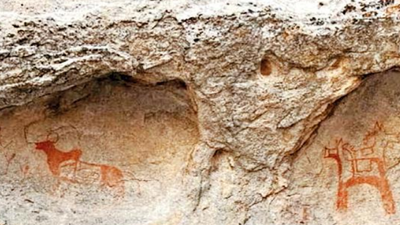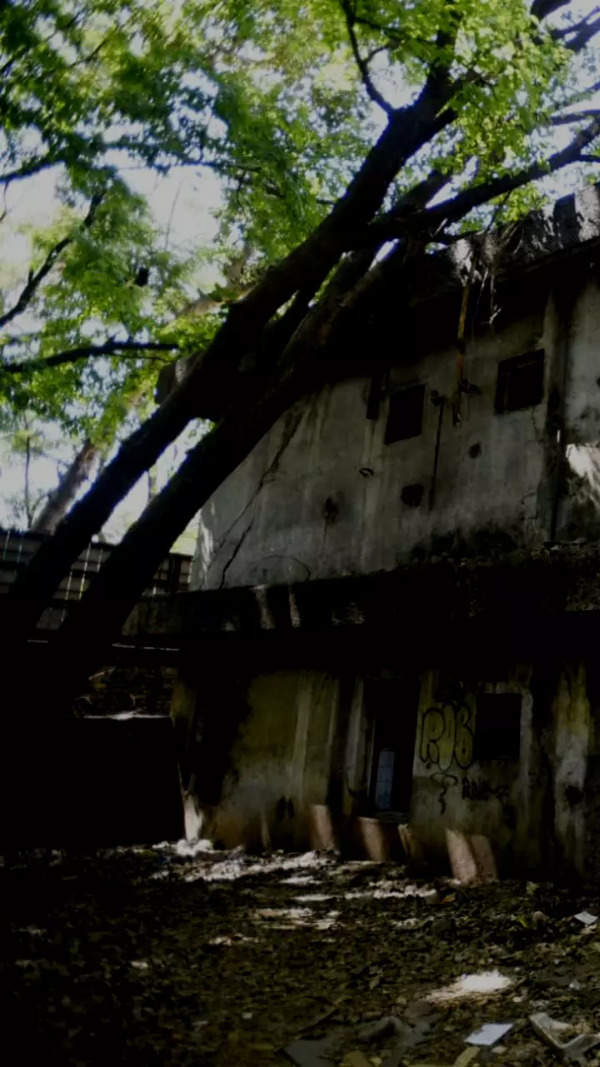- News
- City News
- ahmedabad News
- 5,000-year-old civilization set in stone
Trending Topics
5,000-year-old civilization set in stone

The paintings on the granite rocks of a cave have been made in such a way that they are unscathed by rain, wind and sunlight
VADODARA/AHMEDABAD: The undulating forest of Devgadh Baria, famed for sloth bears, is also a treasure trove of knowledge on the culture thriving during the Middle-Stone age (9,000 BCE to 4,300 BCE).
A forest department team trekking deep inside the forest stumbled upon rock paintings dating back at least 5,000 years, inside a cave.
Interestingly, these invaluable archaeological pieces are being guarded by none other than a sloth bear that resides inside. Forest officials have ascertained the bear's presence with its scat.
The discovery suggests that the area was inhabited by humans in the Mesolithic age and many of the paintings are intact, archaeologists said.
The paintings on the granite rocks of a cave have been made in a way that they are unscathed by rain, wind and sunlight. The paintings include those intact ones on the cave's rock, and some others on other rocks of the hill that have been partly erased over the years. These exist on the Vyavhariya Dungar, a hill situated between Devgadh Baria and Sagtala.
Assistant conservator of forest Prashant Tomar, who photographed the paintings, said that the mountain was in a reserve forest area. "The paintings have remained intact or just partially erased as the cave is located in a protected forest area and the presence of a sloth bear," he said.
Former MS University professor and an expert on rock paintings, V H Sonawane, said, "From the photographs, it looks like the figures drawn on the rock on the hill were of different times. A bull and humans drawn are potentially from the Mesolithic era."
Former MS University professor and an expert on rock paintings, V H Sonawane, who discovered the first rock paintings of Gujarat at Tarsang in the Panchmahal district in 1971, said another painting with horses on it is more recent and could be from the 13th or 14th century. He pointed out that even in Tarsang rock paintings from the Mesolithic era and more recent times were found in the same area.
Sonawane said that such paintings are rare. Apart from Tarsang, other locations where such paintings exist in the state include Chhota Udepur district, Amirgadh in Banaskantha, Idar in Sabarkantha, Thangadh in Surendrangar and Chamardi in Bhavnagar district.
On the paintings in Baria, Sonawane said these were made on granite rocks with red hematite, a ferrous oxide compound found in rocks and soil.
"These should be protected and kept safe. They are an indication that humans lived here in the Mesolithic age. More studies can lead us to other shreds of evidence of human settlement there," he said.
The discovery has kindled hopes that more such paintings and evidence lie hidden inside this forest and provide more information on human habitation here.
Conservator of forests, Vadodara range, Anshuman Sharma, who was first to tweet these pictures said, "Locals told us there are more such boulders with paintings in the forest. We will request the government to get these caves examined by the archaeology department. These paintings are peculiar with animals and some are those of horns."
A forest department team trekking deep inside the forest stumbled upon rock paintings dating back at least 5,000 years, inside a cave.
Interestingly, these invaluable archaeological pieces are being guarded by none other than a sloth bear that resides inside. Forest officials have ascertained the bear's presence with its scat.
The discovery suggests that the area was inhabited by humans in the Mesolithic age and many of the paintings are intact, archaeologists said.
The paintings on the granite rocks of a cave have been made in a way that they are unscathed by rain, wind and sunlight. The paintings include those intact ones on the cave's rock, and some others on other rocks of the hill that have been partly erased over the years. These exist on the Vyavhariya Dungar, a hill situated between Devgadh Baria and Sagtala.
Assistant conservator of forest Prashant Tomar, who photographed the paintings, said that the mountain was in a reserve forest area. "The paintings have remained intact or just partially erased as the cave is located in a protected forest area and the presence of a sloth bear," he said.
Former MS University professor and an expert on rock paintings, V H Sonawane, said, "From the photographs, it looks like the figures drawn on the rock on the hill were of different times. A bull and humans drawn are potentially from the Mesolithic era."
Former MS University professor and an expert on rock paintings, V H Sonawane, who discovered the first rock paintings of Gujarat at Tarsang in the Panchmahal district in 1971, said another painting with horses on it is more recent and could be from the 13th or 14th century. He pointed out that even in Tarsang rock paintings from the Mesolithic era and more recent times were found in the same area.
Sonawane said that such paintings are rare. Apart from Tarsang, other locations where such paintings exist in the state include Chhota Udepur district, Amirgadh in Banaskantha, Idar in Sabarkantha, Thangadh in Surendrangar and Chamardi in Bhavnagar district.
On the paintings in Baria, Sonawane said these were made on granite rocks with red hematite, a ferrous oxide compound found in rocks and soil.
"These should be protected and kept safe. They are an indication that humans lived here in the Mesolithic age. More studies can lead us to other shreds of evidence of human settlement there," he said.
The discovery has kindled hopes that more such paintings and evidence lie hidden inside this forest and provide more information on human habitation here.
Conservator of forests, Vadodara range, Anshuman Sharma, who was first to tweet these pictures said, "Locals told us there are more such boulders with paintings in the forest. We will request the government to get these caves examined by the archaeology department. These paintings are peculiar with animals and some are those of horns."
Start a Conversation
FOLLOW US ON SOCIAL MEDIA
FacebookTwitterInstagramKOO APPYOUTUBE










